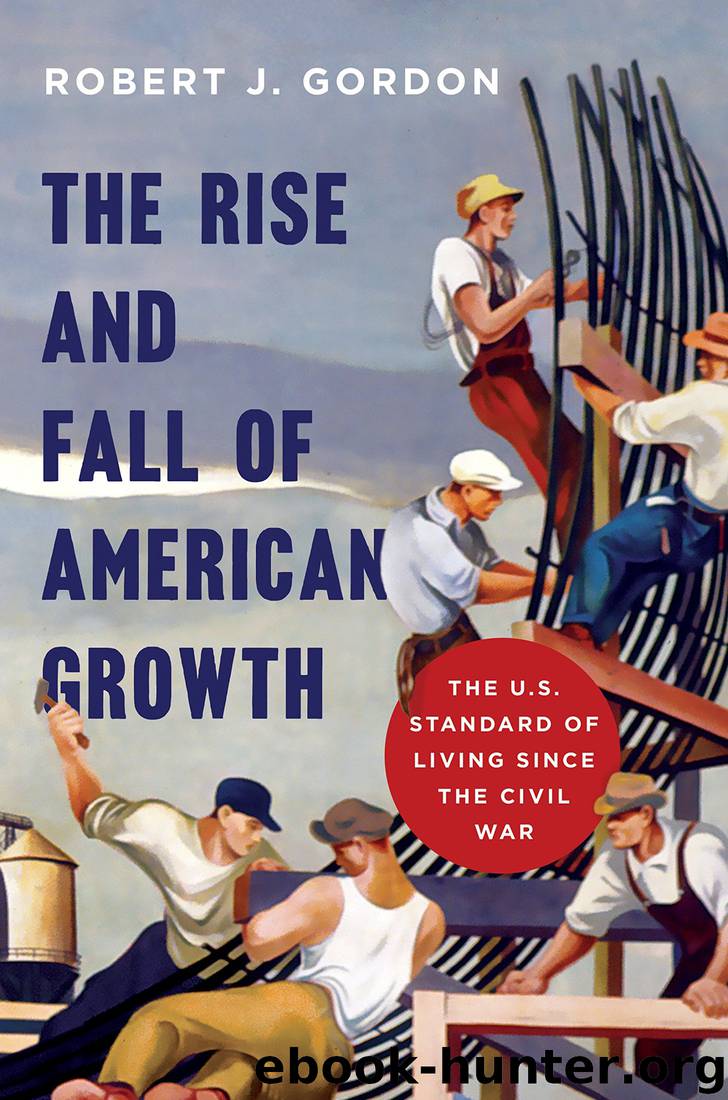The Rise and Fall of American Growth: The U.S. Standard of Living since the Civil War (The Princeton Economic History of the Western World) by Robert J. Gordon

Author:Robert J. Gordon [Gordon, Robert J.]
Language: eng
Format: epub, mobi, azw3
Tags: Business & Money, Economics, Development & Growth, Economic Conditions, Economic History, History, Americas, United States, Biography & History, Economic Policy & Development
Amazon: B0131KW67U
Publisher: Princeton University Press
Published: 2016-01-12T08:00:00+00:00
Figure 11–9. U. S. Commerical Airline Passenger Fatalities Per 100 Billion Passenger-Miles, Seven Year Moving Average, 1940–2013.
Sources: HSUS Df1120, Df1133, Df 1231, Df1236 before 1997, MIT Airline Data Project RPM and NTSB 2013 Preliminary Airline Statistics Table 3 after 1997.
Soon inadequate air traffic control faded away as a cause of airline fatalities, but still manufacturing and maintenance errors could be deadly. On May 25, 1979, an American Airlines DC-10 carrying 271 passengers and crew dived into the ground immediately after takeoff from Chicago’s O’Hare airport. The cause was immediately determined to be the detachment of the left engine, which upon takeoff flipped over the top of the wing, severing hydraulic lines and damaging the left wing. The ultimate cause was determined to be faulty maintenance procedures at American Airlines. Finally, on November 12, 2001, in an eerily similar incident, an American Airlines Airbus A300 immediately after takeoff from New York’s Kennedy airport dived into the Queens neighborhood of Belle Harbor, New York. The cause was determined to be pilot error, as the pilot’s aggressive use of the rudder caused the tail of the plane to snap off, and before the aircraft hit the ground, both engines had fallen off the wing.
These three incidents with their very different causes—inadequate air traffic control, faulty maintenance, and pilot error—appear to have taught airlines and aircraft manufacturers many lessons. To quote the title of Ralph Nader’s famous book, air travel was initially “unsafe at any speed” but now is safer than walking across the street.
AIRLINE PRICES AND THE INITIAL PROMISE OF AIRLINE DEREGULATION
In the history of the U.S. airline industry since World War II, one theme stands out. Air travel rapidly made the transition from a travel mode that was relatively dangerous and expensive to one that opened the world as an affordable destination for millions of Americans. In the words of the epigraph that opens this chapter, air travel “lifted from the human race the curse of distance.” In the 1950s, travelers to Europe still mainly traveled on ships, but the jet plane within a few years caused regular transatlantic ship travel to cease. By the end of the 1960s, most ocean liners were scrapped or converted to cruise ships.
But, surprisingly, the period of most rapid decline in the real price of air travel occurred before the first flight of a jet plane. As shown in figure 11–10, the price of air travel relative to other goods and services declined rapidly from 1940 to 1960, declined at a slower rate from 1960 to 1980, and has experienced no decline at all in its relative price between 1980 and 2014. The growth rate of passenger miles traveled has mirrored the rate of change of the relative price except with the opposite sign, because lower prices stimulate the demand for any good or service.
Download
The Rise and Fall of American Growth: The U.S. Standard of Living since the Civil War (The Princeton Economic History of the Western World) by Robert J. Gordon.mobi
The Rise and Fall of American Growth: The U.S. Standard of Living since the Civil War (The Princeton Economic History of the Western World) by Robert J. Gordon.azw3
This site does not store any files on its server. We only index and link to content provided by other sites. Please contact the content providers to delete copyright contents if any and email us, we'll remove relevant links or contents immediately.
International Integration of the Brazilian Economy by Elias C. Grivoyannis(57383)
The Radium Girls by Kate Moore(10915)
Turbulence by E. J. Noyes(7057)
Nudge - Improving Decisions about Health, Wealth, and Happiness by Thaler Sunstein(6642)
The Black Swan by Nassim Nicholas Taleb(6203)
Pioneering Portfolio Management by David F. Swensen(5615)
Rich Dad Poor Dad by Robert T. Kiyosaki(5162)
Zero to One by Peter Thiel(4834)
Man-made Catastrophes and Risk Information Concealment by Dmitry Chernov & Didier Sornette(4748)
Secrecy World by Jake Bernstein(3788)
Millionaire: The Philanderer, Gambler, and Duelist Who Invented Modern Finance by Janet Gleeson(3575)
Skin in the Game by Nassim Nicholas Taleb(3477)
The Age of Surveillance Capitalism by Shoshana Zuboff(3430)
The Money Culture by Michael Lewis(3291)
Skin in the Game: Hidden Asymmetries in Daily Life by Nassim Nicholas Taleb(3271)
Bullshit Jobs by David Graeber(3190)
The Dhandho Investor by Mohnish Pabrai(3175)
The Wisdom of Finance by Mihir Desai(3086)
Blockchain Basics by Daniel Drescher(2895)
